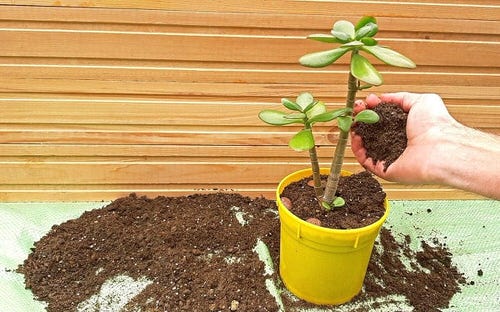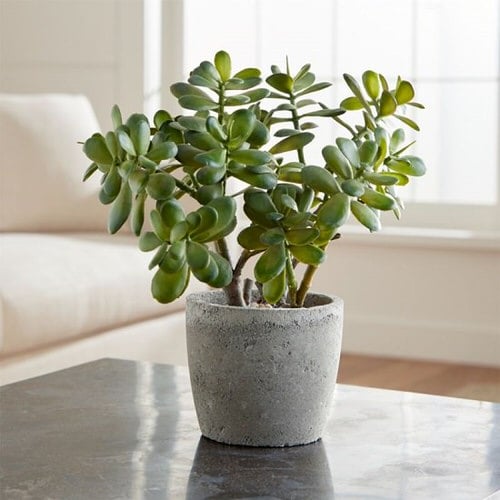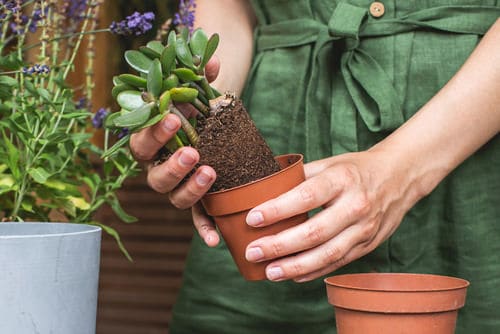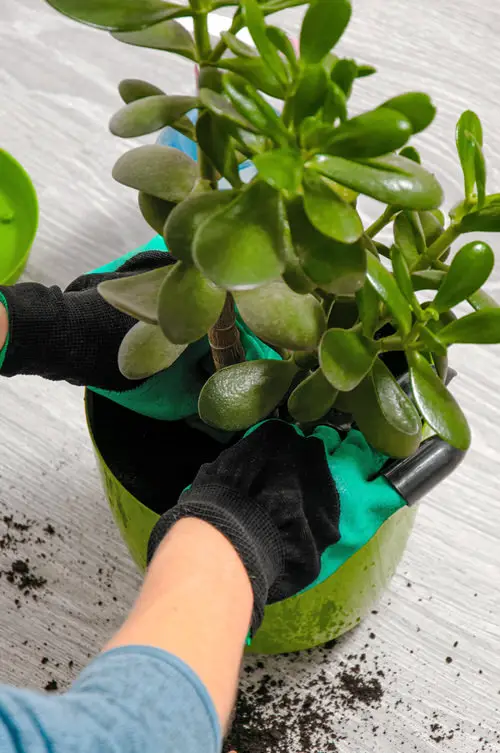Learn How to Grow a Jade Plant From Cuttings and propagate this succulent quickly. Gift it to your friends and family, or have more copies of this good luck plant.

If you want an easy-to-maintain succulent that looks like a tiny little tree, then growing the Jade plant makes perfect sense. The best part is–it multiplies without any difficulties! Let’s have a look at How to Grow a Jade Plant From Cuttings in this guide below.
Here are the best types of Jade Plants you can grow
Best Jade Plant Varieties to Grow from Cuttings
Apart from the common Crassula ovata some of the best varieties you can propagate from cuttings are:
1. Crassula ovata ‘Hobbit’
2. Crassula ovata ‘Gollum’
3. Crassula ovata ‘Jade Tower’
4. Crassula ovata ‘Baby’s Necklace’
5. Crassula ovata ‘Rainbow’
6. Crassula ovata ‘Variegata’
7. Crassula ovata ‘Giant’
8. Crassula ovata ‘Buddha’s Temple’
9. Crassula ovata ‘Variegata Tetragona’
10. Crassula ovata ‘Winter Beauty’
Learn all about how to take care of jade plants indoors
When is the Right Time to Propagate a Jade Plant?
The best time to propagate a jade plant is whenever the environment is warm, and this is why the spring and summer months work perfectly. Cuttings require stable temperatures in the range of 60-85°F or 15-30°C but the best part is you don’t have to worry much about maintaining because it’s a succulent and it prefers dry air.
The best time to propagate a jade plant is during the spring or summer months when the plant is actively growing. Propagating in the winter may result in failure.
However, if you live in a warm climate (USDA Zones 9 to 11) or any other hotter, frost-free part of the world, you can propagate it at any time–even in winter.
Discover Jade Plant Meaning and Symbolism
Things You’ll Need
- Rooting Hormone
- A healthy Jade Plant for trimming
- A cactus mix succulent potting soil, or any seed mix
- Spray bottle filled with water for misting
- Clean, sharp pruning shears or knife
How to Grow Jade Plant from Cuttings?
1. Choose a Perfect Cutting

The chances of successful propagation increase when you collect your cuttings from a healthy plant.
- Cut 4-6 inches long stem just below a leaf node. Remove all the lower leaves from the cutting except those at the top end.
- Do not go for soft or new branches. Also, avoid taking cuttings with cuts and nicks.
- Use a clean pruner to prevent the plant from getting susceptible to fungal diseases.
- After cutting the stem, leave it in a warm and shady part for the open end to dry. During this period, a protective layer called callous will be formed in 3 to 5 days. Remember, healing the cutting is the most important step–SO DON’T SKIP IT!
2. Dip in Rooting Hormone
- After the open end has dried out, dip the cutting in a rooting hormone.
- Rooting hormone can be a powdery or liquid substance that reduces the rooting time and increases the number of roots produced. Have a look at this study to learn about the benefits of a rooting hormone.
This step will speed up the process of propagation.
3. Prepare the Potting Mix

Jade plants, like any other succulents, thrive in a well-draining potting mix.
- Combine equal parts of sand and perlite. Make sure to prepare a well-draining mixture to prevent the conditions of wet feet, which can be fatal for your succulent.
- For best results, plant the cuttings in a succulent or cactus mix. You can also plant them in a seed-starting mix. Check out our article on making succulent potting mix here.
- Jade plants love slightly acidic to neutral soil.
4. Plant the Cutting
As a final step, make a small hole with your finger in the potting mix and plant the cutting into the soil. Press the sides of the stem so that it sits in the soil firmly.
Look at the Succulents That Look Like Jade Plant
Ideal Conditions of Growing a Jade Plant from Cuttings
1. Temperature & Humidity
- The plant propagates best in a temperature range of 60-85 F (15-30 C).
- Do not expose the new plant to temperatures below 50 F (10 C). Also, keep it away from cold drafts as it may cause leaf drop.
- Jade plants prefer low humidity of around 30-50%. You must refrain from misting a jade plant, as normal household humidity is enough for this plant to thrive.
- Also, don’t mist the cuttings; it prefers dry surroundings.
2. Sunlight

Jade plant cuttings prefer bright, indirect light and should be kept away from direct sunlight during propagation. A south- or west-facing window with a curtain or a warm, shady spot in your garden is ideal.
For best results, keep your jade plant in a spot that receives 4-6 hours of bright, indirect sunlight each day.
3. Watering
- The trick to watering a jade plant perfectly is to wet the soil thoroughly till water seeps down from the draining hole, then wait until the soil dries out completely before watering next.
- Young jade plants need to be watered frequently’ while mature plants need less water.
Pro Tip: Do not water from above the leaves, and follow bottom watering.
4. Fertilizers
- Jade plants are not heavy feeders and should be fed only in the growing seasons, i.e., spring and summer.
- Never fertilize a jade plant in winter as the plant goes dormant during this time and does not absorb nutrients from the soil, leading to salt build-up around the roots.
- Use a balanced fertilizer once in 2 weeks, diluted to 1/4 of its strength, during the growing period. Do follow the instructions on the label. Fish emulsion and Epsom salt are some good organic options that aid in overall plant growth.
5. Repotting

- Young jade plants prefer to be repotted in 3-4 years, while the older ones need less frequently.
- Repot the plants only in summer or spring and not in winter when they are incomplete rest. Do not water a jade plant for a week after repotting.




